Alright, car enthusiasts and tire aficionados, buckle up! It’s time to dive into the seemingly cryptic world of tire codes. Have you ever found yourself staring at your tire’s sidewall, wondering what on earth 117v, 117h, 117w, 117t, 117y, 117s, and 117q mean? Does it stand for some secret car enthusiast’s code or maybe a hidden treasure map?
Well, not exactly, but they are indeed incredibly valuable pieces of information. They indicate your tire’s load index and speed rating, crucial factors in keeping you safe on the road. So let’s hit the metaphorical gas and start decoding these mysterious tire inscriptions.
What do 117t, 117s, 117q, 117h, 117r, 117v, 117w mean on a tire?
When you see a tire marked with, let’s say, 117H, there are two critical pieces of information. The number ‘117’ is the tire’s load index, while the letter ‘H’ is its speed rating. The load index represents the maximum weight that the tire can support when properly inflated, while the speed rating denotes the maximum speed at which the tire can safely carry a load corresponding to its load index.
Let’s decode these letters into their respective speed ratings.
| Letter | Speed Rating (km/h) | Speed Rating (mph) |
| T | 190 | 118 |
| S | 180 | 112 |
| Q | 160 | 99 |
| H | 210 | 130 |
| R | – | – |
| V | 240 | 149 |
| W | 270 | 168 |
Keep in mind; these are the max speeds, not the speeds you should be cruising at. It’s always best to follow the speed limits in your area for safety!
What does 117T mean on a tire?
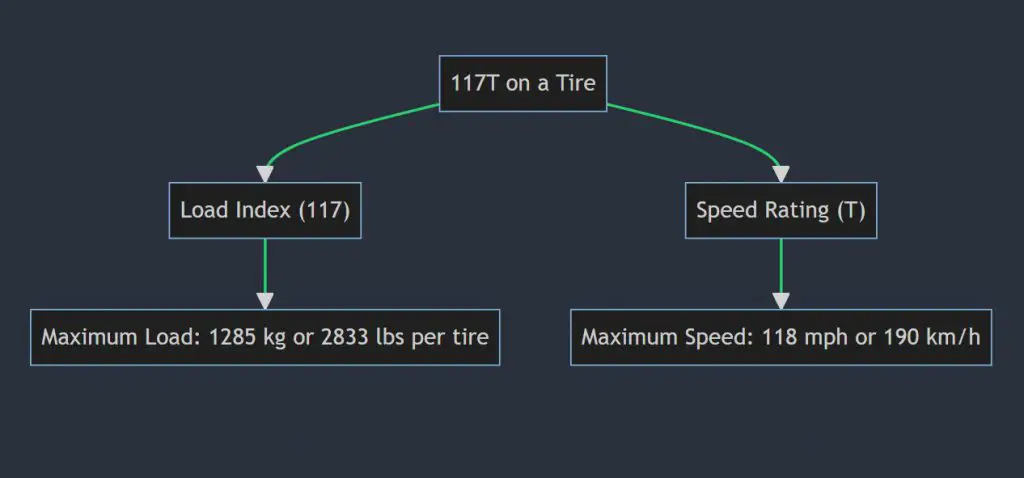
Ah, 117T. The tire that dreams of being as fast as its 117V cousin, but is a bit more humble. A tire marked with 117T indicates that it has a load index of 117 and a speed rating of T.
Load Index 117
The load index 117 indicates that the tire can carry a maximum load of 1285 kilograms (or 2833 pounds, for the non-metric folks out there) when it is properly inflated.
Speed Rating T
The speed rating T stands for a maximum speed of 190 km/h (or about 118 mph). Remember, that’s the top speed, not a recommended cruising speed. Just because your tire can handle such speeds doesn’t mean you should challenge a fighter jet to a race. We know, we know, that’d be a fun story for the grandkids, but let’s stick to safe speeds, alright?
What does 117S mean on a tire?
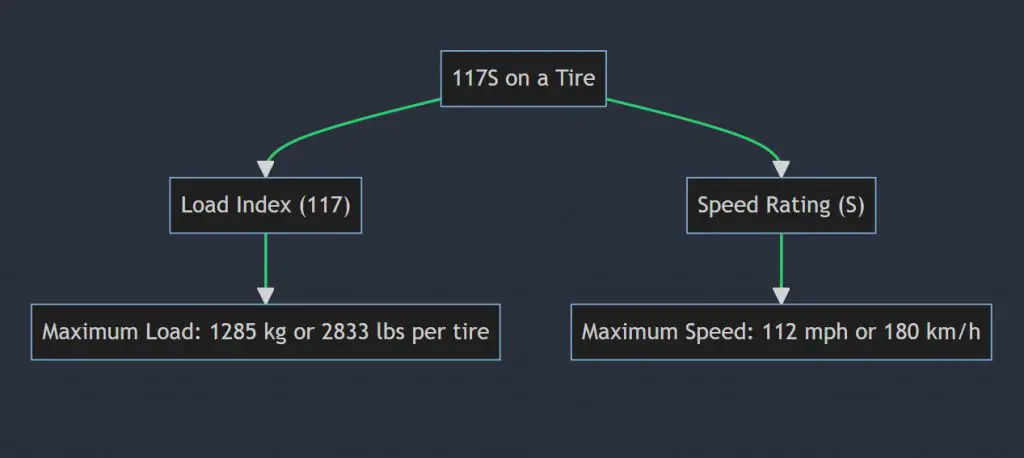
Now onto the 117S. A tire marked with 117S, like its sibling 117T, carries the load index of 117, which we’ve already established, but it’s got a different need for speed.
Load Index 117
Like we mentioned in the 117T section, the load index of 117 tells us that this tire can support a maximum load of 1285 kg (2833 lbs) when it’s at the right pressure. Think of it as the tire’s weightlifting limit. Don’t worry, your tire won’t be entering any bodybuilding competitions anytime soon.
Speed Rating S
This tire, with an ‘S’ rating, can safely run at speeds up to 180 km/h (or around 112 mph). That’s slower than a cheetah, faster than a greyhound, and just the right speed for most car chases in action movies. But remember, just because it’s the tire’s maximum speed doesn’t mean you need to replicate the next Fast and Furious scene.
What does 117q mean on a tire?
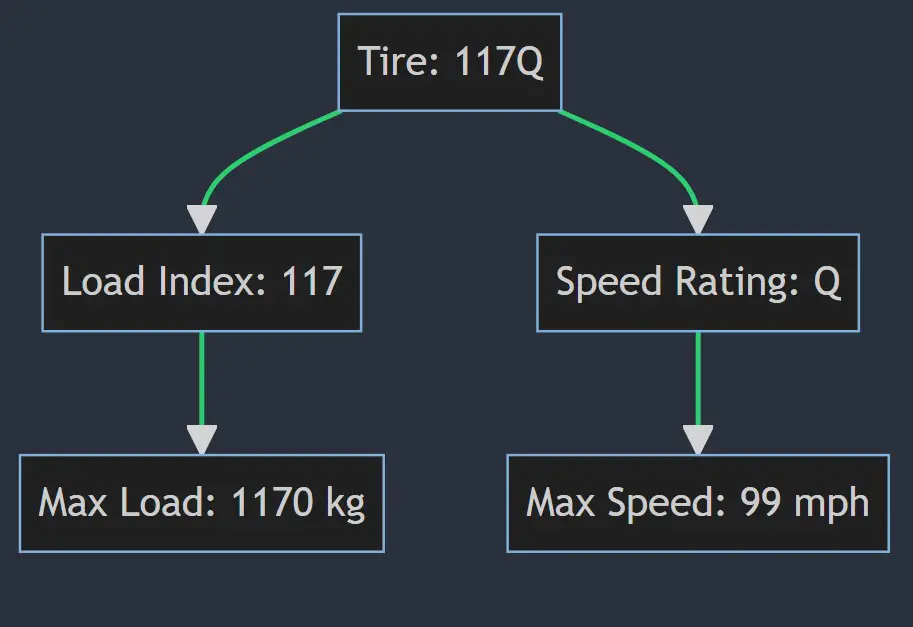
Let’s now turn to our next tire sibling, 117Q. If this tire were a contestant on a game show, the host would probably say, “Come on down, 117Q! You’re the next contestant on ‘The Tire is Right!'”
Load Index 117
Like its other 117-coded siblings, the 117Q tire can carry up to 1285 kg (2833 lbs) when inflated properly. Again, this is its max weight, not a suggestion to load your car with a small elephant (even if it is just a baby one).
Speed Rating Q
The ‘Q’ in 117Q stands for a maximum speed of 160 km/h, or around 99 mph. While it might not win a race against a sports car, it’s definitely not built for slow Sunday drives either. The ‘Q’ rated tires are typically found on winter or studded tires, making them perfect for making your own ‘Frozen’ reenactment, sans the singing and magical ice powers, of course. Just remember, even Elsa couldn’t control her powers at first, so always drive safely.
What does 117h mean on a tire?
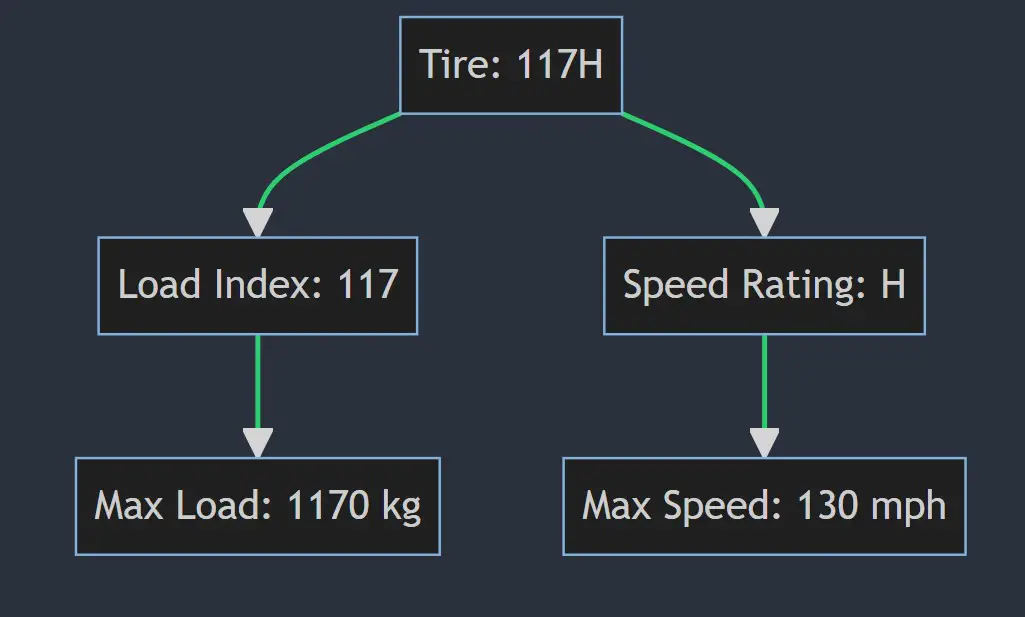
Now let’s meet the next sibling in our tire family, the 117H. It’s like the Goldilocks of the bunch – not too fast, not too slow, but just right for many drivers.
Load Index 117
Once again, our tire sibling with the 117 load index can support a maximum load of 1285 kg (or 2833 lbs for those who measure their weights in burger stacks). So no, it can’t carry your house, but it can definitely handle your car with your family and groceries.
Speed Rating H
The H-rated tire stands for a max speed of 210 km/h, or about 130 mph. This tire is like the older, more mature sibling who has learned to balance responsibility and fun. It’s like a sensible adult who occasionally enjoys a bit of rollercoaster excitement but knows when to say “Enough!” Always remember though, just because the tire can handle such speed, doesn’t mean you should try and set a new land-speed record on the freeway!
What does 117r mean on a tire?
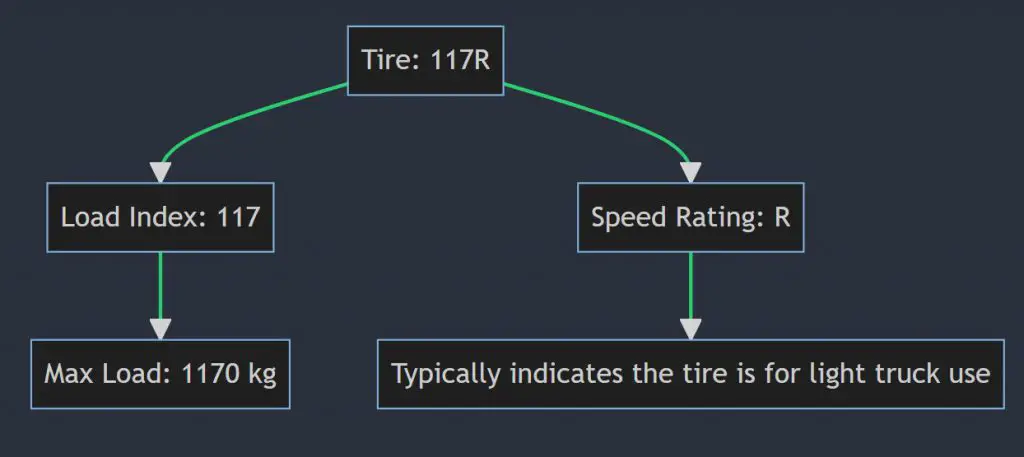
Ah, the curious case of the 117R tire. This one’s a bit different, as R doesn’t correspond to a speed rating, but represents the construction of the tire.
Load Index 117
You know the drill by now, right? A load index of 117 means this tire can carry up to 1285 kg (or 2833 lbs). Yep, that’s right, the same as a small hippo. Just because it could technically carry one, though, doesn’t mean it should.
Tire Type R
R in the tire code represents a Radial tire. This indicates that the tire’s layers run radially across the tire, from one bead to the other, rather than diagonally. The vast majority of modern tires are radial tires due to their many benefits, including longer tread life, better steering control, and smoother rides. Just remember, the ‘R’ doesn’t give you the right to ride like a daredevil!
What does 117v mean on a tire?
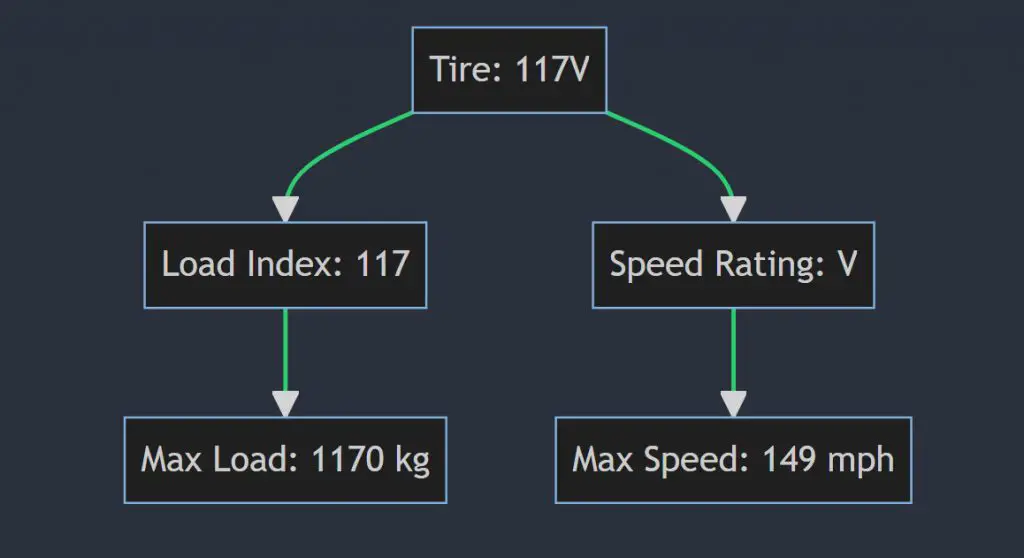
And finally, meet the speed demon of our tire family: the 117V. This tire’s motto might be “I feel the need…the need for speed,” but remember, safety first!
Load Index 117
Here’s the last repetition of our favorite fact: A 117 load index means this tire can support a maximum load of 1285 kg (or 2833 lbs). It’s gotten to the point where you’re probably dreaming about this number, right?
Speed Rating V
The V-rated tire can safely travel at speeds up to 240 km/h or roughly 149 mph. It’s like the rebellious sibling who got a motorcycle and a leather jacket. However, no matter how “cool” the tire may be, driving at safe speeds is still the coolest thing you can do on the road.
So there you have it! From T to V, you’ve now learned the ABC’s of tire load and speed ratings. Remember, these numbers and letters are not suggestions or challenges; they’re safety guidelines designed to keep you and other drivers safe on the road. So stay safe, drive responsibly, and remember, your tires aren’t just circles of rubber – they’re your vehicle’s best friend.
What does 117w mean on a tire?
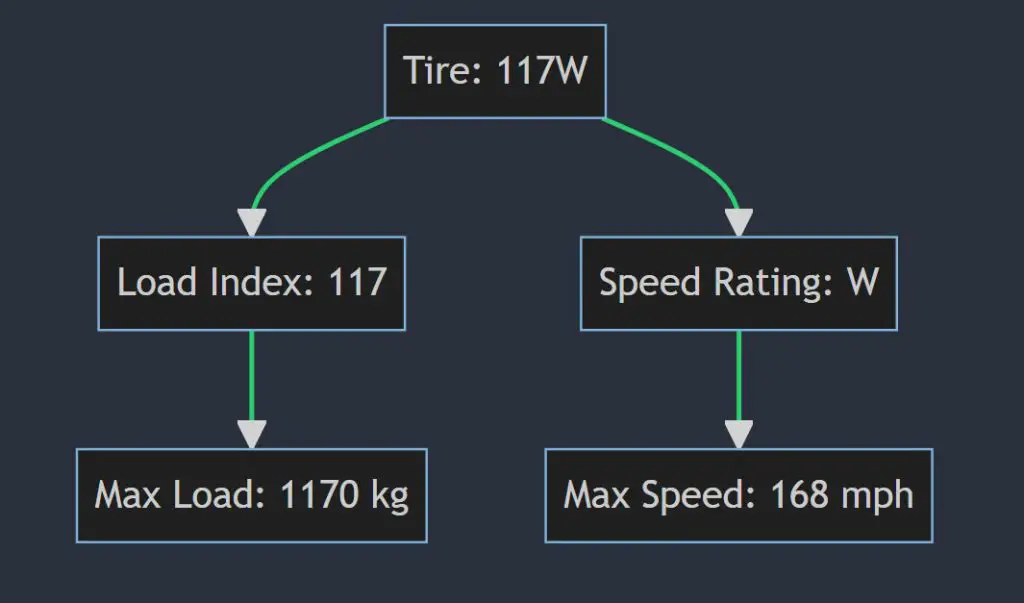
Fasten your seatbelts, folks, because we’ve saved one of the speediest for last: the 117W. This tire could give even the hare in “The Tortoise and the Hare” a run for its money.
Load Index 117
By now, you’re probably reciting this in your sleep. A load index of 117 means that the tire can handle a maximum load of 1285 kg (2833 lbs). No more, no less.
Speed Rating W
The W-rated tire has a maximum speed of a whopping 270 km/h, or about 168 mph. That’s right, this tire could give even some sports cars a run for their money. But remember, these high speeds are strictly for test tracks and professional racing circuits, not your daily commute. Just because the tire could star in “Fast & Furious 23” doesn’t mean it should!
FAQs
What does 117t xl mean on a tire?
The ‘XL’ stands for Extra Load. An XL-rated tire can handle more weight than a standard tire at the same size. So a 117T XL can carry a heavier load at a speed of up to 118 mph.
What does 117h xl mean on a tire?
Similarly, a 117H XL tire is an Extra Load tire with a max speed of 130 mph. Remember, XL doesn’t mean extra-large, but extra load.
117T vs 113T, what’s the difference?
The key difference lies in the load index. 117T tires can carry more weight than 113T tires but both have the same speed rating of T.
117T vs 121S, what’s the difference?
Again, the difference is in the load index. A 121S tire can carry more weight than a 117T tire, but the speed rating of S means it’s intended for slower speeds than T-rated tires.
117T vs 117H, which is better?
Neither is “better” as they’re designed for different speeds. The 117H tire is rated for higher speeds than the 117T.
117T vs 113H, what’s the difference?
117T tires can carry more weight and are rated for slower speeds, while 113H tires can carry less weight but are rated for faster speeds.
117T vs 120Q, what’s the difference?
The 120Q tire can carry more weight than a 117T tire, but the Q rating means it’s designed for slower speeds.
Recap and Summary
Wow, we’ve certainly covered a lot of ground (pun fully intended)! So, what did we learn?
The numbers and letters on your tire, such as 117V, 117H, 117W, 117T, 117Y, 117S, and 117Q, are not some secret code for car aficionados. They are actually incredibly important pieces of information. The number is the tire’s load index, telling you how much weight the tire can support when properly inflated. The letter is the tire’s speed rating, indicating the maximum speed at which the tire can safely carry its maximum load.
However, remember that these are limits, not suggestions. Always adhere to the legal speed limits on the road, and make sure your vehicle is not overloaded.
In the end, remember that the most important component in any vehicle is not the engine, not the tires, but the driver. Drive safely, responsibly, and keep on rolling!
Alternative Tire Size Codes of Similar Specifications

AR Jeet has been a tire mechanic for over 2years. He has worked on all types of vehicles, from cars and trucks to RVs and ATVs and motorcycles. He has seen it all when it comes to tires, and he knows how to fix them.
AR Jeet is a tire expert, and he is passionate about his work. He loves to help people keep their vehicles running smoothly, and he is always happy to answer any questions that people have about their tires.
If you need help with your tires, or if you just want to learn more about them, then AR Jeet is the man to talk to. He will be happy to help you out, and he will make sure that you get the best possible solution.
He has a blog [Tirespick.com] where he writes about all things tire-related, and he is always happy to help people with their tire needs. Know more about AR Jeet.
